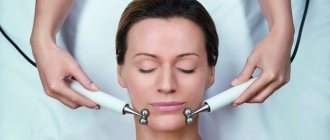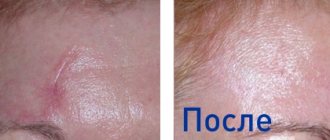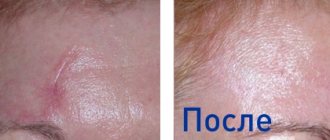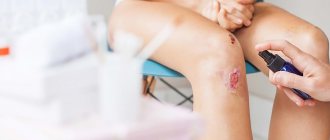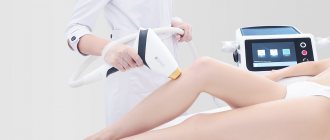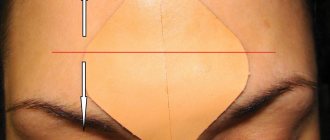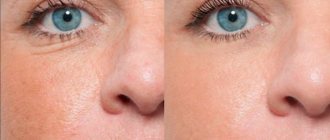Types of scars
The cause of scars is damage to the dermis as a result of mechanical (including during surgery), thermal (burn) or chemical exposure.
Also, the cause of the appearance of scars and cicatrices can be a skin disease, in particular acne. Some types of scars (stretch marks, stretch marks) are the result of stretching of the integumentary tissue. The mechanism of scar development is as follows. At the site of damage, granulation tissue grows - temporary connective tissue, the task of which is to quickly fill the defect. Soon, fibrous tissue develops at the site of granulation, which is subsequently replaced by full connective tissue. If the defect is significant, the regeneration process stops at the stage of fibrosis. Fibrous tissue differs in its properties from connective tissue, and therefore such an area stands out against the background of healthy skin.
Depending on the morphology and appearance of scars, there are:
- Normotrophic scars. They are formed in situations where the volume of fibrous tissue corresponds to the volume of surrounding areas. The scars do not rise above the surface of the skin and are pink or pale in color.
- Hypertrophic scars. Areas with excessive development of fibrous tissue. They rise above the surface of the skin and are dark red, bluish or purple in color.
- Atrophic scars. They are formed when there is a deficiency of tissue in the area of damage. Such scars are typically located below the level of healthy skin and are pale in color.
- Keloid scars. They are similar to hypertrophic ones, but have an unfavorable prognosis - they do not go away on their own and are prone to relapses. Removing keloid type scars is the most difficult task.
Scars have several other characteristic features. The skin in the scar area is devoid of hair and sebaceous glands. In atrophic scars there are no melanocytes (or their number is minimal), which is why they do not darken under the influence of ultraviolet radiation. The sensitivity of the skin in the scar area may also be reduced due to damage to the nerve endings.
Scar camouflage: indications, properties, features
High-quality scar camouflage can significantly smooth out skin unevenness or completely restore it from scars. A similar service appeared relatively recently along with the active development of tattooing and its distribution. The use of micropigmentation to combat scars can be divided into two types: painting the affected skin with a lighter pigment that covers dark tones, or using dry needle technology, which stimulates the natural production of collagen, which is responsible for the restoration of the skin.
Types of camouflage permanent makeup
Applying the permanent consists of the technician selecting the shade closest to the natural tone. The problem area is painted over with a special dye. Preparation for the procedure, its implementation and subsequent processing are similar to traditional tattooing.
The dry needle technique, which is also called collagen stimulation, is carried out as follows: the master works with the skin, as when applying pigment, but without the use of dyes. The specialist takes a tool with twenty needles of minimal thickness. With camouflage scars of both types, you don’t have to be afraid of negative consequences: the methods are completely safe and non-traumatic. They have the shortest recovery period and provide good results.
Important details:
- The best master will use more than one color of paint, but will mix several shades, allowing him to get as close as possible to the client’s natural skin tone. This is exactly how the specialists of Elena Olshanskaya’s permanent makeup studio work, achieving the most natural shades, regardless of the visitor’s skin phototype.
- Not every scar can be corrected: it must be at least 1 year old. Removing scars that are older than 10 years can also pose some difficulties. The pink color of the scar indicates that the regeneration process is still ongoing, so you need to wait for it to finish, and then use one or another method or a combination of them (first the “dry needle” technique, and then applying pigment).
Indications for aesthetic micropigmentation of scars
- Burns;
- Concealing scars from surgery;
- Concealing acne marks;
- Post-operative scars from any type of surgery, including aesthetic ones.
The camouflage of scars can only be dealt with by an experienced, qualified specialist who can choose the right shade and carry out the procedure efficiently, effectively, and safely for the skin.
Comparison of laser resurfacing and aesthetic micropigmentation for scar camouflage
| Laser resurfacing | Tattoo | |
| The procedure is traumatic | Depends on the laser chosen and the type of procedure performed. | Invasive but minimally traumatic. |
| Duration | Elimination of skin irregularities can take from 45 minutes to 2 hours. This is influenced by the area of the treated area, the characteristics of the epidermis, including the phototype (the darker the tone, the higher the risk of hyperpigmentation). | It depends only on the size of the scar that the client wants to remove. |
| Type of anesthesia used | Local external (spray, gel) or general anesthesia when treating large areas and aggressive laser exposure. | Only local anesthesia through the use of a gel or spray to eliminate pain. |
| Price | A fairly expensive procedure, the price of which is affected by the type of laser used and the treatment area. | Compared to laser resurfacing, tattooing is significantly cheaper, regardless of whether you choose to paint over dark pigment or use a dry needle. |
| Duration of the recovery period | From several weeks to several months. The first days after resurfacing are especially important and require the use of a sterile dressing, as well as complete absence of contact of the treated area with any external irritants, including the client’s skin. The recovery process includes the formation of crusts that “come off” in red spots that disappear over a period of up to six months. | Recovery takes several days. Swelling may occur and disappear within 1-2 days. If the client chooses to apply a coloring pigment, then the full result will be visible in 3-4 weeks. |
| Required number of procedures | Individually, it depends on the depth and size of the scar, as well as the characteristics of the skin. | Individually. |
As you can see, laser resurfacing with scar camouflage has both common aspects and serious differences. Let us highlight the main advantages of tattooing over laser use:
- Affordable cost of micropigmentation compared to laser correction. The price may vary several times depending on the equipment used.
- When tattooing, only local external anesthesia is used, which has a positive effect on the body and has virtually no contraindications, except for individual intolerance to the components of the anesthetic.
- A noticeably shorter recovery period (in some cases shorter by months), no need to apply a sterile bandage.
- Simple and easy to follow at home recommendations for skin care after the procedure.
- Less trauma to the skin, which is especially important with the dry needle technique, which does not involve applying pigment, but introducing a needle without dyes to stimulate collagen, which is responsible for regeneration processes.
Before using laser resurfacing or scar camouflage, you should consult a specialist. The client may be determined to get rid of a scar one way or another based on its invasiveness, cost, or other factors. But only after consulting with a professional can you make the right choice. Make sure that the person you are contacting is a true master of his craft. Trust the best performers who will take care of selecting the optimal way to get rid of the problem that has arisen, and will do it efficiently, quickly and within the shortest possible time frame.
Scar removal methods
Scar removal is carried out using cosmetology and plastic surgery methods. The following procedures for resurfacing and removing scars are widely used:
- Laser resurfacing.
- Cryotherapy.
- Chemical and mechanical peelings.
- Hormonal therapy (local).
- Dermabrasion.
- Surgical removal of scars.
The safest and most effective method is laser scar removal. The unique properties of the laser beam allow the procedure to be carried out with minimal discomfort for the patient and without damaging healthy skin. To achieve the desired effect, 2 to 5 sessions are required. Recovery after the procedure takes place within a few days, without significant restrictions in terms of work and social activity.
The main stages of the laser scar resurfacing procedure
- The entire length of the scar is covered with a local anesthetic - a special cream. A film is placed on top of it. Then you need to wait 15-20 minutes for the anesthesia to take effect.
- The cosmetologist launches the laser. Having determined the required power, the doctor begins grinding. The procedure lasts from a couple of minutes to an hour, depending on the number of scars. Afterwards, you apply cold to the sanding area for a short time.
- The cosmetologist applies healing ointment to the scar. After this, you receive personal recommendations for care and leave the clinic. The next visit should be scheduled 3-4 weeks after the session. Usually our patients immediately sign up for their next procedure.
You can always see what laser scar resurfacing looks like in photos and videos on our Instagram.
Laser scar resurfacing: principle of operation
The principle of scar removal using a laser beam is based on targeted and controlled damage to areas with a predominance of fibrous tissue. The purpose of the procedure is to destroy (in a controlled manner) the fibrous scar and launch regenerative processes that will go through a full recovery cycle and end with the formation of full-fledged connective tissue, which will not differ in structure from healthy skin.
A cosmetologist diagnoses the scar, determines its type, as well as the morphotype and phototype of the skin. After this, the necessary beam parameters are set in the program of the laser scar removal device, including its intensity and depth. The accuracy of the therapeutic effect is adjusted to within 1 micron, which allows complete removal of scars and eliminates the risk of damage to adjacent tissues.
Laser scar resurfacing involves a pulsed effect on collagen fibers and cellular elements of the fibrosis focus. The laser has a photothermal effect and causes heating of the target area. A controlled increase in temperature leads to the destruction of abnormal formations. Decomposition products provoke the release of biologically active substances and stimulate regenerative processes, as a result of which normal healthy skin is formed in place of scars.
Types and stages of scars
- Normotrophic - flat: occur as a result of mild burns, shallow cuts. Slightly different in color from surrounding tissues;
- Atrophic – retracted: are a consequence of acne, chickenpox and other minor skin trauma. Usually have a light shade.
- Hypertrophic - convex: such scars can remain after severe damage to the skin (lacerations, dog bites, other injuries), as well as due to careless application of postoperative sutures.
When is laser scar resurfacing necessary?
After surgery if there are postoperative scars
After accidents and injuries
For post-acne
Laser usually does not remove keloid scars. Otherwise there are no restrictions. The scar may be flat, raised, light or dark. Any stretch mark can be easily removed by laser.
Areas to be deleted:
Face
Eyelids
Lips
Body
Modern equipment allows you to work with very thin and sensitive skin. The risk of pigmentation and scarring is minimized. Scars that are up to 3 years old are best removed.
Keloid scar: what is important to know
There are areas of the body that are more prone to the formation of keloids than others: the chest, neck, upper shoulders and the nasolabial triangle area. This type of scar differs from other scars in that it grows larger than the original damage to the skin and overlaps with healthy tissue. Keloid scars are divided into young (up to 5 years) and old (5-10 years). A young keloid is red, with a glossy surface, an old one is paler, its surface is usually uneven.
Removal of keloid scars is carried out only after a thorough differential diagnosis - the tactics here are fundamentally different than when working with ordinary scars.
How does laser scar removal work?
Laser scar removal is a procedure that will reduce the depth of any scar and lighten it. The laser seems to grind down the upper layers of the skin, removing dense scar tissue, and evens out the boundaries between healthy skin and new dermis. In its place, collagen and elastin are actively formed, a normal healthy skin structure is formed, so this service is recommended to everyone who has deep scars.
Before the procedure, you should wait about six months until the inflammatory process passes, the redness in the scar area subsides, and the suture, if any, heals properly. Otherwise, scar tissue may grow.
Cost of laser resurfacing of scars and scars
Prices for the procedure are determined taking into account factors such as the area and depth of the scar, the degree of problem of the skin, and the type of laser used for resurfacing. The cost ranges from 5,000 – 60,000 rubles.
To get a detailed consultation and make an appointment with a cosmetologist at the International Hemostasis Clinic, call the number or fill out the online feedback form. Our administrators will contact you and answer all your questions.
Laser facial resurfacing
Laser eyelid resurfacing
Laser resurfacing of stretch marks
Price:
Full face + Eyelids 22000 Complete face without treatment of the eyelid area 18000 Cheeks 9000 Neck 12000 Cleavage 12000 Face + Neck + Décolleté 36000 Face + Neck + Décolleté + Eyelids 46000 Face + Eyelids + Neck 25000 Lower + Upper eyelids 11000 Lower eyelids 7000 Crow's feet area 7000 Scar 1 cm² 1500 Stretch bars 10 cm² 7000 Rear of hands 9000 Perioral region (around the mouth) 6600We are waiting for you for the procedure!CO2 laser resurfacing price in Moscow at the Biomi clinic is the lowest!
Indications and contraindications for the procedure
Laser scar resurfacing is prescribed to patients who want to painlessly and quickly get rid of pronounced skin defects. Using a laser, you can remove scars of any nature - after burns, surgery, injuries, etc.
Before starting the procedure, it is important to make sure there are no restrictions. To do this, after consultation and an initial examination, the doctor gives the patient a referral for a diagnostic examination, the results of which will help confirm or refute contraindications. Laser scar resurfacing is not prescribed for patients diagnosed with the following pathologies:
- tumors of benign and malignant etiology;
- autoimmune diseases;
- hormonal or endocrine disorders;
- congenital or acquired immunodeficiency;
- blood diseases;
- tendency to form keloid scars;
- chronic dermatological diseases in the acute stage;
- allergic reaction to ultraviolet radiation;
- varicose veins, thrombophlebitis;
- wounds, erosions, inflammatory processes in the treatment areas;
- severe mental disorders, epilepsy.
The procedure is also contraindicated for women during pregnancy, lactation, and menstrual bleeding. Laser resurfacing is not prescribed for patients suffering from acute respiratory infections or acute respiratory viral infections, which are accompanied by an increase in temperature and a general deterioration in well-being. In this case, it is necessary to wait until complete recovery and only then begin therapy.
Rehabilitation period after scar resurfacing
During the first week, you need to use an antibiotic ointment, as well as Bepanten. This is necessary for rapid restoration of the skin. For the first couple of days, your doctor may recommend not getting the scar wet. You cannot touch the scar with your hands, especially dirty ones. The exception is the application of ointments and creams to the skin.
Redness and swelling may persist for up to 3 days, then the skin begins to peel off. It is strictly forbidden to remove crusts that have formed, scratch the scar, or use scrubs and peels.
Be sure to apply sunscreen before going out in the sun for 14 days. It is best to use products with SPF throughout the course of scar removal and for two weeks after its completion.
If you come across a review that complications appeared after laser scar removal, most likely the patient violated the doctor’s instructions. Laser scar correction is the most gentle and effective way to restore skin aesthetics.
Laser benefits
The main advantage is the possibility of local impact only on scar tissue. Healthy skin is not damaged, and this makes it possible to shorten the rehabilitation period. Secondly, a significant advantage is high efficiency - even the most pronounced defects after the procedure are leveled out and become less noticeable. Finally, safety - unlike surgical excision and exposure to chemical acids, laser does not involve blood or deep damage.
To make an appointment for keloid scar removal in Moscow , call us or fill out the form on our website. Clinic “BL” is located within walking distance from the Oktyabrskoye Pole metro station, at the address: st. Marshala Rybalko, house 2, building 6.
